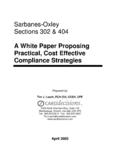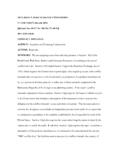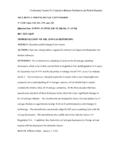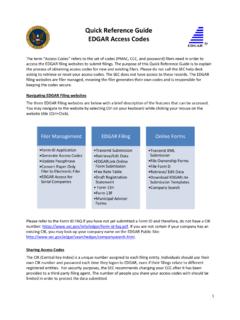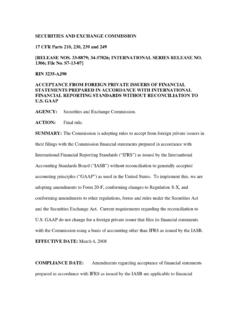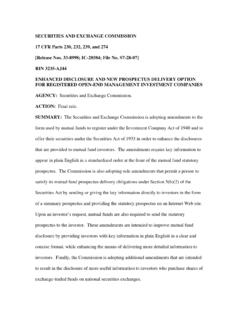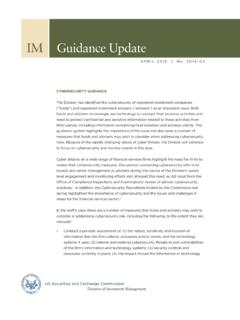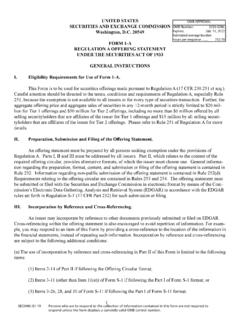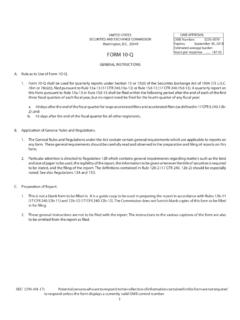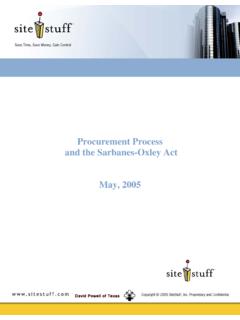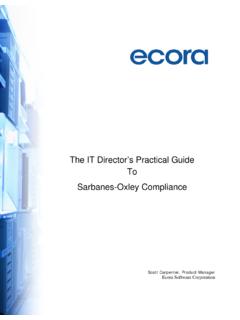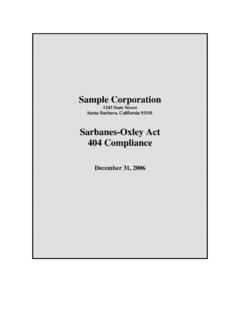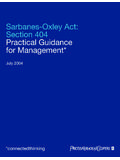Transcription of Report Pursuant to Section 704 of the Sarbanes-Oxley Act ...
1 Report Pursuant to Section 704 of the Sarbanes-Oxley Act of 2002 Table of Contents I. Executive Summary II. The Statutory Language III. Objectives, Scope and Methodology IV. Results of the Study - Areas of Reporting Most Susceptible to Fraud A. Improper Revenue Recognition 1. Overview of Findings 2. Discussion of Representative Cases and Description of Issues a. Improper Timing of Revenue Recognition i. Holding Books Open After Close of a Reporting Period ii. Bill-and-Hold, Consignment Sales, and Other Contingency Sales iii. Multiple Element Contracts or Bundled Contracts b. Fictitious Revenue c. Improper Valuation of Revenue 3. Analysis and Conclusions B. Improper Expense Recognition 1. Overview of Findings 2. Discussion of Representative Cases and Description of Issues a. Improper Capitalization/Deferral - Failure to Record Expenses or Losses b. Overstating Ending Inventory Values c.
2 Improper Use of Restructuring and Other Liability Reserves d. Understating Reserves for Bad Debts and Loan Losses e. Failure to Record Asset Impairments 3. Analysis and Conclusions C. Improper Accounting in Connection with Business Combinations 1. Overview of Findings 2. Discussion of Representative Cases and Description of Issues a. Improper Asset Valuation b. Improper Use of Merger Reserves c. Inappropriate Application of Purchase/Pooling Methods 3. Analysis and Conclusions D. Other Areas of Improper Accounting 1. Overview of Findings 2. Discussion of Representative Cases and Description of Issues a. Inadequate Disclosures in Management Discussion and Analysis ( MD&A ) and Elsewhere in Issuer Filings b. Failure to Disclose Related Party Transactions c. Inappropriate Accounting for Non-monetary and Roundtrip Transactions d.
3 Improper Accounting for Foreign Payments in Violation of the FCPA e. Improper Use of Non-GAAP Financial Measures f. Improper Use of Off-Balance Sheet Arrangements 3. Analysis and Conclusions V. Results of the Study - Persons Involved in Financial Reporting Violations A. Overview of Findings B. The Individuals Charged 1. Senior Management 2. Mid-Level Management 3. Counsel 4. Customers VI. Results of the Study - The Role of the Auditors A. Overview of Findings B. The Charges in Cases against Auditors C. The Audit Failures D. Size of Audit Firms Where Audit Failures Occurred E. Discussion of Representative Cases F. Analysis and Conclusions G. Provisions of Sarbanes-Oxley Act Applying to Auditors VII. Proposals Based on the Study A.
4 Pre- Sarbanes-Oxley Enforcement Tools B. Provisions of Sarbanes-Oxley Act 2 3 C. Proposals 1. Uniform Reporting of Restatements 2. Issuing an Interpretive Release, or Adopting Revisions to Commission Rules, on Management s Discussion and Analysis of Financial Condition and Results of Operations 3. Production of Internal Reports Without Waiver of Privilege 4. Access to Grand Jury Materials 5. Nationwide Service of Process for Testimony in Commission Litigation VIII. Conclusion Exhibit A - Listing of Actions Filed Report Pursuant to Section 704 of the Sarbanes-Oxley Act of 2002 I. Executive Summary1 The past year has been marked by a series of restatements of financial statements by prominent corporations resulting in billions of dollars lost by investors. To address concerns raised by these restatements, and to restore public trust in the financial markets, Congress passed the Sarbanes-Oxley Act of 2002 ( the Sarbanes-Oxley Act ), which the President signed into law on July 30, The Sarbanes-Oxley Act, among other things, creates an independent accounting oversight board; provides more enforcement tools to the Securities and Exchange Commission ( Commission ); restricts non-audit services by accounting firms; holds corporate executives accountable for the accuracy of financial reports; increases criminal penalties for securities fraud; and provides for the separation of investment banking and investment analysis.
5 Section 704 of the Sarbanes-Oxley Act directs the Commission to study enforcement actions over the five years preceding its enactment in order to identify areas of issuer financial reporting that are most susceptible to fraud, inappropriate manipulation, or inappropriate earnings management (the Study ). In addition, Section 704 directs the Commission to Report its findings to Congress, including a discussion of recommended regulation or legislation (the Report ). This Study involved the review of all of the Commission s enforcement actions filed during the period July 31, 1997 though July 30, 2002 (the Study period ) that were based on improper issuer financial reporting, fraud, audit failure, or auditor independence violations. Over the Study period, the Commission filed 515 enforcement actions for financial reporting and disclosure violations arising out of 227 Division of Enforcement investigations3 (these investigations are referred to hereafter as enforcement matters ).
6 4 See Exhibit A for a listing of actions filed during this period. The 515 actions included 869 named parties, consisting of 164 entities and 705 During the Study period, the number of enforcement actions involving issuer financial reporting violations or fraud increased from 91 in the first year of the 1 References to accounting standards are for informational purposes only, and should not be construed as recitations of generally accepted accounting principles ( GAAP ) or interpretations by the Commission. 2 Corporate and Auditing and Accountability, Responsibility, and Transparency Act of 2002, No. 107-204. 3 Some of the actions brought during the Study period involved conduct that occurred before the Study period. 4 During the same time period, the Commission filed a total of 2508 enforcement actions, arising out of 1390 investigations. 5 More than one action may result from a particular investigation.
7 Although most of the enforcement matters related to one issuer, there were matters involving multiple issuers. Study to 149 in the last year of the Of these 515 actions, 186 were federal civil actions and 329 were administrative Of the 869 named parties, the Commission charged 593 with fraud in connection with the reporting violations: 511 individuals, and 82 entities. Study Year Number of Actions Involving Issuer Financial Reporting Violations Year One 91 Year Two 60 Year Three 110 Year Four 105 Year Five 149 The Study found that the Commission brought the greatest number of actions in the area of improper revenue recognition: 126 of the 227 enforcement matters involved such conduct, including the fraudulent reporting of fictitious sales, improper timing of revenue recognition, and improper valuation of One hundred one enforcement matters involved improper expense recognition, including improper capitalization or deferral of expenses, improper use of reserves, and other understatement of expenses.
8 Additionally, 23 enforcement matters involved improper accounting for business combinations. One hundred thirty-seven enforcement matters involved other accounting and reporting issues, such as inadequate Management s Discussion and Analysis ( MD&A ) disclosure and improper use of off-balance sheet arrangements. In approximately 10% of the enforcement matters, the accounting or disclosure issue was reflected in financial statements that were included in an issuer s registration statement filed with the Commission in connection with an Initial Public Offering ( IPO ). It should be noted that the numbers discussed in this Report reflect historical data on actions filed in the last five years, and may not necessarily reflect their relative importance in the Enforcement program in the future. For example, off-balance sheet arrangements and non-GAAP financial measures are relatively new areas of enforcement. The numbers do not necessarily reflect the magnitude and impact that these areas of conduct may have on investors in the future.
9 The Study revealed that the majority of the persons held responsible for the accounting violations were members of issuer senior management. The Study found that 157 of the 227 enforcement matters involved charges against at least one senior manager. In these enforcement matters, charges were brought against 75 Chairmen of the Board, 111 Chief Executive Officers ( CEOs ), 111 Presidents, 105 Chief Financial Officers 6 For purposes of the Study, Year One is July 31, 1997-July 30, 1998; Year Two is July 31, 1998-July 30, 1999; Year Three is July 31, 1999-July 30, 2000; Year Four is July 31, 2000-July 30, 2001; and Year Five is July 31, 2001-July 30, 2002. 7 Included in the 329 administrative proceedings is one Report of Investigation Pursuant to Section 21(a) of the Securities Exchange Act of 1934 ( 21(a) Report of Investigation ). 8 Most of the 227 enforcement matters involved more than one type of improper conduct.
10 Because of this overlap, it would not be meaningful to aggregate these numbers. 2 ( CFOs ), 21 Chief Operating Officers ( COOs ), 16 Chief Accounting Officers ( CAOs ), and 27 Vice Presidents ( VPs ) of In addition, the Study determined that the Commission brought charges against 18 auditing firms and 89 individual auditors. The Study found that violations by auditors were not limited to any particular size of firm, and resulted largely from auditors failing to gain sufficient evidence to support the issuer s accounting, failing to exercise the appropriate level of skepticism in responding to red flags, and failing to maintain independence. The Study concluded that 135 issuers in the 227 enforcement matters filed restatements that were related to conduct investigated in the enforcement Of these restatements, the majority involved either revenue or expense recognition. Section 704 directs the Commission to include in this Report a discussion of recommended steps to address concerns identified by this Study.
